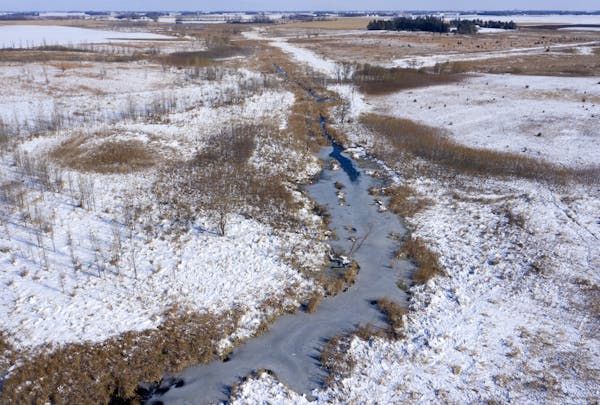STURGEON LAKE, MINN. – A bridge is supposed to be over the water. Not in it.
But outside this Pine County town, a bridge has been crumbling into the Willow River for years, and nobody seems to know who's responsible for it.
The township says it's not. The county says it's not. The state says it's not.
That leaves Daniel Ring, who's afraid he'll get stuck holding the bag — or, in this case, the bridge.
Ring owns the land on both sides of the river that the bridge once crossed. For nearly a decade now, he's been trying to get somebody — anybody — to do something about the 50-foot-long span, built by Windemere Township in the 1930s.
Ring owns 200 acres along the river, living on the north 50 acres since 1989, with another 150 acres to the south that the bridge gave access to.
The bridge once was a substantial structure with steel trusses, heavy wood planking and concrete abutments. Now, after decades of neglect, the bridge teeters unsteadily with one end in the water. The abutments, undercut by the stream, are pulling away from the banks.
Ring worries that a canoer or snowmobiler might run into the bridge someday and be seriously injured. If that were to happen, he's afraid he'd be held liable. He also is worried that he could be ordered to remove the bridge at his own expense.
Mainly, he's amazed that a bridge could just be left to rot with nobody in charge.
"Do you think that if you or I, as private citizens, built that bridge and let it fall in the river, that they'd just forget about it?" he said. "For a government entity to build a bridge, neglect a bridge and then abandon that bridge, leaving it to the landowners, is absolutely absurd."
According to court records, the bridge on Wetherille Road was last repaired by the township in 1974. Since then, it's been left to the elements.
Ring went so far as to sue the township a few years ago to force it to maintain the bridge. But he lost his case.
State law says that if a township road hasn't been maintained in more than 25 years, the township can't maintain it without the express permission of voters. In Ring's case, township residents voted against spending any money on the bridge.
Since the road hadn't been maintained in more than 25 years, that lets the township off the hook, according to the court ruling.
DNR uncertain, too
Meanwhile, the Minnesota Department of Natural Resources had twice ordered the township in 2014 to repair or remove the bridge. But since Ring's court case was decided in the township's favor, the DNR says it's not sure who's responsible for the structure.
"It is important to the DNR that abandoned structures are removed from public waters over time," DNR spokesman Darrell Schindler said. "This situation is complicated, however, by the fact that ownership of the bridge structure is still not determined, the site is difficult to access and the structure's removal will likely be costly."
According to Ring, those costs might fall to him. After the township voted not to maintain the bridge, he said that a town official told him the bridge was now his responsibility.
"If they had said, 'You know what? We're not going to fix this bridge. There aren't enough people living back there and it's not worthwhile,' I could have wrapped my head around that and put it behind me," Ring said.
"But then to just dump it on me? To hit me like that and leave that behind, it's almost too much."
It's not fair to criticize the township for writing off Wetherille Road and its bridge, said Steve Fenske, general counsel for the Minnesota Association of Townships. As rural populations have declined in recent decades, townships have had to decide where to spend their resources. Opting not to maintain a low-volume road is a reasonable decision a board might make.
"Town roads are a very different amenity than city, county and state roads," Fenske said. "Town roads are typically gravel, serving few people per road because of the rural character of townships.
"Many roads are not needed to the extent they had been in the past. Over time, towns directed spending and maintenance to the places that needed it."
Windemere Township decided that the road running through Ring's land, along with the bridge, wasn't used enough to warrant maintenance, said Claire Strandlie, who was on the township board when it decided to write off the road and bridge.
"It would have taken a lot of money to do anything down there, and for no reason," Strandlie said.
Mark LeBrun, the Pine County engineer, said he's seen similar disputes over township roads.
"It's a pretty common thing with people wanting a township to maintain a road, and the township not wanting to maintain it," LeBrun said. "That's kind of a theme. The elected leaders are elected to make these decisions."
Costs up to $25,000?
LeBrun hasn't seen the bridge on Ring's land, but he said the cost to remove a typical steel truss bridge from that era might run anywhere from $10,000 to $25,000.
But according to Fenske, the law is unclear on who might own the bridge structure and who might be responsible for removing it.
Meanwhile, Ring will continue to politely pester officials at all levels of government, hoping that someone will figure out what to do with the bridge. But he's not optimistic.
"Anybody that has anything to do with government, if you talk to them about this, they just get this blank look in their eyes," he said. "It's absolutely crazy."
John Reinan • 612-673-7402

Prosecutor shake-up in Mary Moriarty's office in murder case against State Trooper Ryan Londregan

Israel-Hamas war creates 'really fraught times' at Minn. colleges

Sexually transmitted diseases in Minnesota are down, but HIV and newborn syphilis cases are up

